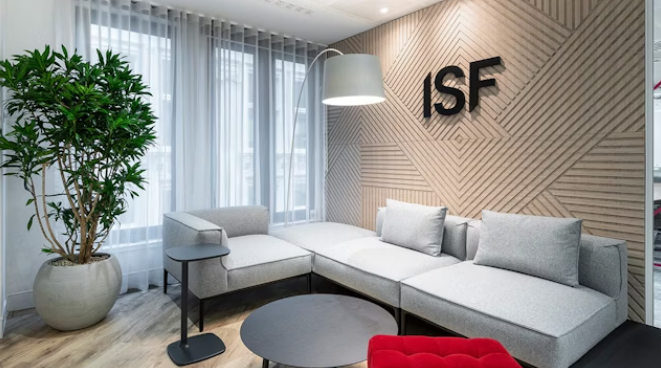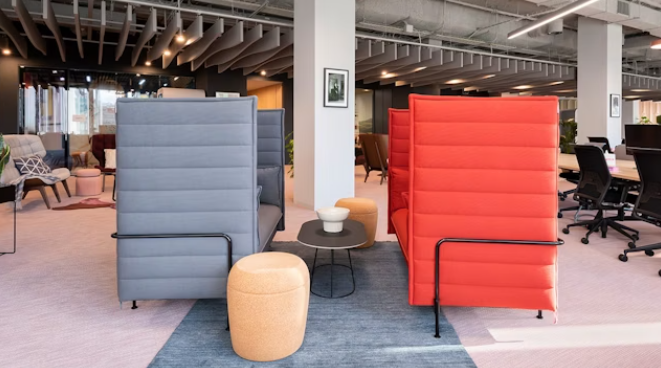20 Office Design Ideas for 2024
Date submitted:20/02/2024
We’ve put together 24 creative office design ideas that can be used to inspire workspaces of all sizes and types.
If you’re moving offices and looking for design ideas, or just looking to renovate your existing office, there’s something in here for everyone. We hope you find these ideas useful and inspiring.
01 – Hybrid Office Design
With hybrid working in full swing in 2023, it has also given companies creative license to make significant office design improvements. When reviewing space plans and layout options, our office design team always recommend including these dedicated spaces for concentration, collaboration, and relaxation, in addition to the traditional workstations, which are equally important.

02 – Eye-Catching Office Entrances
If studies on first impressions are any guide, you only have 27 seconds to make a good first impression. Additionally, 70% of people form their first impressions before any communication takes place. Office entrances (reception areas, lobbies, entryways, and corridors) are key elements in creating first impressions for a company brand. Think about the snap judgments formed by visitors, clients, prospective candidates, and new starters as they are exposed for the first time to your office reception area or lobby. Reception desks should be more than a cosmetic afterthought, they should be a design-led centrepiece that expresses the corporate identity.

03 – Maximise Natural Light
With80-90% of our days spent indoors, it may not be surprising that natural light is an important factor in planning office spaces. In fact, an HR poll of 1,614 employees, published in the Harvard Business Review, shows access to natural light is the number one attribute workers want in their office environment. Further studies have shown that increasing natural light can have a significant impact on everything from mood to creativity and concentration.

04 – Improve Fresh Air and Natural Ventilation
The benefits of fresh air are numerous. 20% of the air we breathe is used by the brain; so having fresh air ultimately leads to clearer thinking, focus and concentration. Studies have also proven that oxygenated blood can significantly elevate brain serotonin synthesis. This in turn can elevate a sense of happiness and well-being in the workplace. In fact, a Harvard study of 7 US cities found that doubling the acceptable rate of ventilation in office buildings led to an 8% increase in employee productivity.

05 – Optimise Office Space
Office space utilisation has become increasingly important. All workplaces contain a number of “in-between spaces” or “dead spaces”. Think corridors, under stairs and other nooks and crannies that have not previously been utilised for any purpose. One of the most prevalent current office design trends is the increasing use of these unconventional spaces which are transformed into functional work areas in the form of small huddle booths, informal meeting spaces or even private one-person pods.

06 – Design for Workplace Wellbeing
Designing for workplace wellbeing is likely to become more important as competition to attract and retain the very best staff intensifies. Many companies are creating staff-centric workplaces with well-being at their core. The benefits of designing any workplace with wellbeing as a key priority are numerous, and consequently, companies may find it useful to spend time thinking about how wellbeing can be improved.

07 – Ergonomics and The End of Endless Sitting
There is mounting scientific evidence of the detrimental health effects of prolonged sitting. As the trend towards health and workplace wellbeing continues, we may well see fundamental changes in the way offices are designed.
Applications include:
- Ergonomic office chairs that accommodate natural movement and encourage good posture
- Sit-stand desks that allow better posture and avoid repetitive strain when sitting
- Tall tables to encourage standing meetings
- Breakout areas with motivational seating to avoid pure desk-based work
- Hybrid office spaces that encourage movement and reduce repetitive strain.

08 – The Use of Multiple Colours
Colour can make a big impression. While many companies look to just use their own brand palette, we always recommend considering other tones which subtly denote what certain spaces are designed for. For instance, soft colours improve concentration, and vibrant colours enhance collaboration and creativity.

09 – Artwork in the Workplace
Artwork in the workplace has numerous positive effects. It has a powerful impact on mental health and wellbeing by creating a sense of calmness. It also improves productivity and creativity and softens the mood in an office.
10 – Agile, Flexible Working
While the pandemic put flexible working centre stage, the transition to flexible working has long been in motion. We’ve seen it in various forms – from job sharing and flexitime to working from home, part-time work, staggered hours and compressed hours. It is indeed a key feature of the modern workplace; and having an agile, flexible, and adaptable office is crucial in matching the needs of the workforce and attracting and retaining the best talent.

11 – Technology in the Workplace
The modern office has come to rely extensively on technology to remain competitive, achieve efficiencies and improve employee productivity. Perhaps most alluring, is that the investment in technology often helps cut down the time and money required to achieve tasks. Technology allows workplaces to automate and rationalize operational processes and daily activities. It enables employees to get essential work done even outside the office, as well as keep in touch with colleagues.

12 – Smart Office Buildings
We’re starting to see buildings becoming increasingly embedded and integrated into the digital world that surrounds us. This isn’t some technology fad, it’s a trend that’s here to stay and will be increasingly integrated into workplaces of the future.

How does the office benefit from bringing nature indoors? There is lots of anecdotal evidence of the good feelings that come from interacting with nature – our so-called “nature fix”. But what evidence is there for it? In an experiment, students at the University of Michigan were given a brief memory test, they were then divided into two groups and asked to take a walk. The first group walked through an arboretum and the 2nd group was along a busy city street. When they returned, both groups wrote the test again. The group that walked in natural surroundings did 20% better than the group that walked along a busy city street.
But it’s not only the effects on memory, plants can also impact our mood, lower our stress levels, as well as have various other health benefits. Another study showed that people spending just two hours a week with nature reported improved health and greater satisfaction than those that didn’t.

14 – A Focus on Health and Wellness
Workplace wellbeing has been around forever, or so it seems, and while once seen as a fad, it is now becoming the accepted norm in organizations of all sizes. But this is particularly true post-pandemic with the transition back to work. More and more companies are becoming health conscious and embracing proactive workplace wellbeing programmes and promoting them as part of the employment package in what is a particularly competitive market to attract the best talent. Great staff want to work in the best possible environment and as a result, workplace wellbeing has shifted towards the top of the agenda.

15 – Relaxing Breakout Areas
A breakout area is a space separate from the usual working area where employees can relax, eat, socialize, and have informal discussions and meetings. The modern workplace centers around staff and their experience interacting with the space. It’s not just about the physical workplace anymore but more about how the space makes staff feel and what it’s like to work there. A workplace is now a critical tool that can help to attract (and retain) the best and brightest talent, and consequently, companies are increasingly investing in creating workplaces where staff love working.

16 – Unconventional Workspaces
When we mention unconventional workspaces, what we mean are those areas that in the past have not been used or even considered as spaces where staff could work from – think corridors, nooks and crannies, or even an open space under the stairs with bean bags or sofas. Technology has of course driven this trend and enabled staff to work from anywhere within the workplace with plug-and-play spaces located throughout many offices.

17 – Creating Open Spaces
Open collaborative office space design isn’t just a fancy phrase for a breakout area or meeting space. An open space is where teams can congregate to collaborate. These open spaces are often equipped with comfortable soft seating, whiteboards, and screens with sharing capabilities so staff can easily share ideas.

18 – Creating Quiet Spaces
With all the benefits of open-plan offices, there are also challenges. Studies have shown that over 50% of people have difficulty concentrating in open plan offices, with an estimated 15% decrease in productivity due to lack of concentration. A popular solution for the noise created in open plan offices is acoustic pods and booths. They allow for one-on-one meetings and team meetings, while also providing ‘quiet zones’ for creativity and relaxation. Unlike the traditional use of cubicles and glass room dividers, small meeting pods and booths don’t require planning permission. Pods come in different shapes and sizes to suit different purposes. From two-person meeting pods to hybrid pods fitted with video conferencing, there’s a range to suit all formats. Ultimately, they achieve a happier and more productive workforce in a space with less rigid divisions.

19 – Reducing Office Partitioning
Traditional walled partitions are becoming less popular and alternatively, office designers are now using alternative materials to create dividers to define spaces. Examples include nature-inspired bamboo walls with shrubbery, metal display cabinets and acoustic panels, and crate shelving with plants.
Offices are removal walls and hard divisions to provide staff with open spaces to work and as a subtle means to promote a culture of openness and transparency. Enclosed meeting rooms and cubicle walls are out in favour of open, collaborative, and social spaces that are defined not by walls, but by a mix of divider units, wooden slats, carpet variances and colour.



